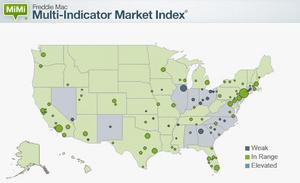 MCLEAN, VA--(Marketwired - Jul 27, 2016) - Freddie Mac (OTCQB: FMCC) today released its Multi-Indicator Market Index® (MiMi®), showing two additional states, Mississippi and Maryland, and eight metro areas entering their historic benchmark levels of housing activity: Louisville, Kentucky; Jacksonville, Florida; Allentown, Pennsylvania; Omaha, Nebraska; Syracuse, New York; Detroit, Michigan; Milwaukee, Wisconsin; and Lakeland, Florida.
MCLEAN, VA--(Marketwired - Jul 27, 2016) - Freddie Mac (OTCQB: FMCC) today released its Multi-Indicator Market Index® (MiMi®), showing two additional states, Mississippi and Maryland, and eight metro areas entering their historic benchmark levels of housing activity: Louisville, Kentucky; Jacksonville, Florida; Allentown, Pennsylvania; Omaha, Nebraska; Syracuse, New York; Detroit, Michigan; Milwaukee, Wisconsin; and Lakeland, Florida.
The national MiMi value stands at 85, indicating a housing market that's on the outer range of its historic benchmark level of housing activity, with a +1.05 percent improvement from April to May and a three-month improvement of +2.39 percent. On a year-over-year basis, the national MiMi value has improved +7.30 percent. Since its all-time low in October 2010, the national MiMi has rebounded 43 percent, but remains significantly off from its high of 121.7.
News Facts:
- Thirty-eight of the 50 states plus the District of Columbia have MiMi values within range of their benchmark averages, with Hawaii (97.8), Oregon (97.1), Utah (96.9), Montana (96.6) and Colorado (96.4) ranking in the top five with their scores closest to their historical benchmark index level of 100.
- Seventy-five of the 100 metro areas have MiMi values within range, with Honolulu, HI (99.8), Salt Lake City, UT (100.2), Los Angeles, CA (99.6), Nashville, TN (101.5), and Portland, Oregon (98.4) ranking in the top five with their scores closest to their historical benchmark index level of 100.
- The most improving states month over month were North Carolina (+1.85%), Georgia (+1.82%), Florida (+1.69%), Mississippi (+1.65%) and Tennessee (+1.60%). On a year-over-year basis, the most improving states were Florida (+14.73%), Oregon (+14.64%), Colorado (+13.68%), Nevada (+12.36%) and New Jersey (+12.23%).
- The most improving metro areas month over month were Chattanooga, TN (+3.45%); Orlando, FL (+2.50%); Detroit, MI (+2.39%); and Charlotte, NC; Greensboro, SC; and Palm Bay, FL all improving (+2.24%). On a year-over-year basis, the most improving metro areas were Orlando, FL (+20.25%); Tampa, FL (+17.27%); Denver, CO (+16.20%); Cape Coral, FL (+15.51%); and Palm Bay, FL (+15.29).
- In May, 45 of the 50 states and 88 of the top 100 metros were showing an improving three-month trend. The same time last year, 46 of the 50 states, and all of the top 100 metro areas were showing an improving three-month trend.
Quote attributable to Freddie Mac Deputy Chief Economist Len Kiefer:
"Nationally, MiMi in May registered 85, a 7.3 percent year-over-year increase and the 49th consecutive month of year-over-year increases. Many of the Western markets continue to see strong home sales. However, it's the Southern states where MiMi continues to register some of the strongest gains buoyed by an improving employment picture. For example, the majority of Southern states showed stronger employment growth than the national average and all of the eight markets in Florida that MiMi tracks are now back to their historic benchmark levels of housing activity."
The 2016 MiMi release calendar pdf is available online.
MiMi monitors and measures the stability of the nation's housing market, as well as the housing markets of all 50 states, the District of Columbia, and the top 100 metro markets. MiMi combines proprietary Freddie Mac data with current local market data to assess where each single-family housing market is relative to its own long-term stable range by looking at home purchase applications, payment-to-income ratios (changes in home purchasing power based on house prices, mortgage rates and household income), proportion of on-time mortgage payments in each market, and the local employment picture. The four indicators are combined to create a composite MiMi value for each market. Monthly, MiMi uses this data to show, at a glance, where each market stands relative to its own stable range of housing activity. MiMi also indicates how each market is trending, whether it is moving closer to, or further away from, its stable range. A market can fall outside its stable range by being too weak to generate enough demand for a well-balanced housing market or by overheating to an unsustainable level of activity.
For more detail on MiMi see the FAQs. The most current version can be found at FreddieMac.com/mimi.
Freddie Mac was established by Congress in 1970 to provide liquidity, stability and affordability to the nation's residential mortgage markets. Freddie Mac supports communities across the nation by providing mortgage capital to lenders. Today Freddie Mac is making home possible for approximately one in four home borrowers and is the largest source of financing for multifamily housing. Additional information is available at FreddieMac.com, Twitter @FreddieMac and Freddie Mac's blog FreddieMac.com/blog.
The financial and other information contained in the documents that may be accessed on this page speaks only as of the date of those documents. The information could be out of date and no longer accurate. Freddie Mac does not undertake an obligation, and disclaims any duty, to update any of the information in those documents. Freddie Mac's future performance, including financial performance, is subject to various risks and uncertainties that could cause actual results to differ materially from expectations. The factors that could affect the company's future results are discussed more fully in our reports filed with the SEC.
